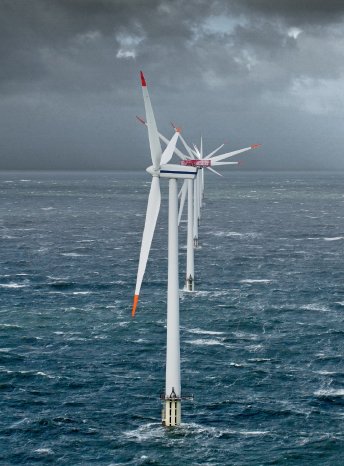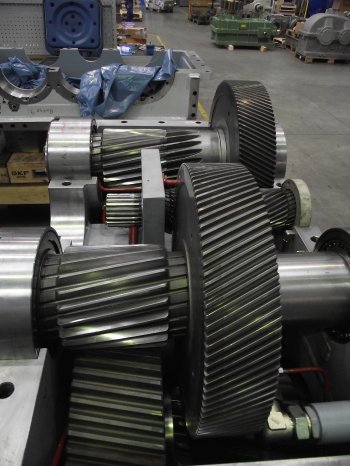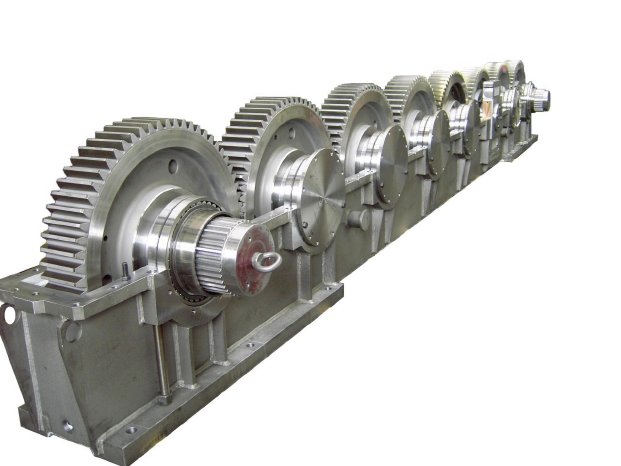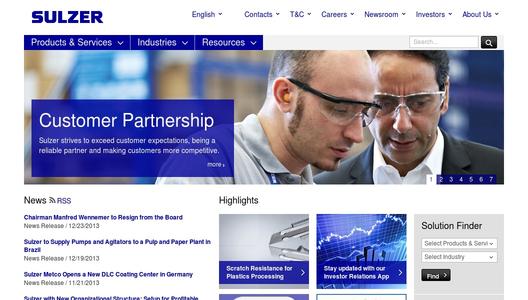Improved surfaces can be achieved by depositing thin coatings or by heat treatment of the steel components. Application areas are the manufacturing of parts mounted in wind power plants or the optimization of finished components. This article describes compatible coatings and treatments as well as established application areas.
Wind Power
For some of the population, wind power plants are a degradation of landscapes or coasts. But for numerous industrial nations they are the environmentally friendliest technology for energy generation and for meeting energy demands. Furthermore, it has been shown that energy generated by wind power is more cost-effective than nuclear-generated electricity when the disposal, final storage and risk factors for a nuclear accident have been taken into account.
Today wind energy is the fastest growing sector of the renewable energy sources.
Facts & Figures
During the 1980s, the first wind power plant farms were installed. Since then the development of wind energy is proceeding quickly in Germany and other countries. 1 million tons of steel is used per year for the produc-tion of wind turbines in Germany — three times more than in the ship building industry. Actual data from the German Wind Energy Association (Bundesverbands der Win-denergie, BWE) and the VDMA (German Engineering Federation; Verband Deutscher Maschinen- und Anlagenbau) show that in 2013 the energy generated by wind power plants in Germany will match energy production from all energy generation sources for the record year of 2002. As the world slowly turns away from the nuclear power, wind energy becomes more important.
The actual performance data show how fast this market is growing. In 2012, the world-wide installed power was 282,587 MW, the year before 238,000 MW and in 2010 approx. 197,000 MW was installed. This means a yearly increase of 15%. Ambitious plans see an increase to 460,000 MW by 2015. China, as the biggest producer of wind energy together with the USA and Germany, produce about 60% of the worldwide installed capacity. Nevertheless, these countries have a great potential for the coming years. Yet other nations have a higher proportion of wind energy for their national energy consumption. Here Denmark is tops with 28% while Spain and Portugal place second and third with approx. 15%. In Germany, as greatest wind energy producer in Europe, the wind energy is only 10% of the total energy consumption.
During the next years wind power plants onshore as well as offshore are planned. By the end of 2012, the world had 2052 offshore wind power plants (73 wind power farms) with a generating capacity of 5863 MW. Those offshore power plants located further away from the coast have a more favorable acceptance with populations. The German government, for example, will focus more on offshore power plants in the future and they want to invest in wind power plants as part of the electricity supply system expansion according to the amendment of the Renewable Energies Act (EEG; “Erneuerbare Energien Gesetz”) .
Highest Requirements
The requirements for wind power plants are very diverse, affected by differences in local and meteorological conditions. Offshore plants in particular have to deal with corro-sion due to salt and dampness. Also “re-powering” will play an important role in the next years as the design of wind power plants increase in size and performance. Repowering replaces older plants with new-er, higher performance power plants. Be-sides requirements for minimizing down-times, increasing performance and efficien-cy, wind power plants have to withstand enormous and often changes forces by ex-ternal influences.
The powertrain of a wind power plant is es-pecially subjected to high loads and stresses. At the same time, this makes them sus-ceptible to higher maintenance and repairs. Downtime caused by drive train and gearbox damage is particularly high, as data of the Fraunhofer Institute show (see figure 2). To maximize plant profitability, downtimes and maintenance work has to be minimized. The most common causes for wind power plants failures are wear and component fatigue, such as on gearwheels, which lead to long downtimes.
The construction materials used have to withstand enormous stresses, diverse forces, high impact momentum and torsion. Gearboxes that change the rotary speed and the torque of the rotor and generator are common.
There, for example, a comparatively slow rotor rotational speed (in the range of 6 – 20 min-1) is transformed into a high generator speed of 900 – 2000 min-1 to achieve a high-efficiency energy generation factor. Over the entire life of a modern wind energy power plant, this corresponds to a transmission capacity of approx. 144 million rotations of the rotor shaft or 15 billion rotations of the generator shaft.
To guarantee a high and reliable perfor-mance level it is necessary to use steel that has an enormous wear and fatigue strength. Furthermore, the material must have high toughness and vibration strength to resist the strong stresses.
The flanks of gears, for example, have to be protected against wear and pitting. High surface pressure is exerted on the gear tooth when engaged and plastic deformation has to be prevented on the ductile outer zone. Likewise, the flanks have to withstand wear and fatigue from high frictional forces.
Surface Solutions that Reduce Downtimes
Sulzer Metaplas, a Sulzer Metco company, already has established surface technologies for braking devices (pistons, brake discs and saddles), valve parts, hydraulic components and gears. Depending on the service demands, thin film coatings are deposited by PVD (Physical Vapor Deposition) or PACVD (Plasma-Assisted Chemical Vapor Deposition). Heat treatment processes like case hardening or nitriding are also used.
Case Hardening
Case hardening — carburizing, hardening, tempering — is used to generate high hardness in the outer zone and toughness, as well as an elastic core at the same time.
Drive shafts require a ductile outer zone and a tougher core due to high torsion and impact loads. Case hardened or induction-hardened gears and drive shafts fullfil the required surface hardness, hardness of the outer zone and ductility with a tough core. So they withstand wear and the specific high pressures required for wind turbine applications.
Case hardening takes place at a high temperature of 950 °C to 1050 °C such that the carburizing and tempering process can cause deformation. Common carburizing depths are between 0.1 to 4.0 mm. Based on the high case hardness, the post treatment of tooth after deformation is not a problem, although the post treatment may lead to reduced case hardness. Shafts and large gears have to be aligned after the case hardening process.
Properties of case hardening:
- Surface hardness of case hardened steels: 45 – 64 HRC
- Case hardening depth Eht: max. 4 mm
- Post treatment (grinding, aligning) due to deformation
Nitriding
Plasma nitriding by E.IONIT is an excellent alternative for case hardening, especially for big gears and gear rings.
The reason is the low nitriding process temperature of 400 to 550 °C that prevents deformation of the components. Generally the process temperature is at 30 °C below the tempering temperature of the treated steel. Deformation can be prevented. However, deformation may appear, for example in precision fit components, the process tem-perature can be lowered below 500 °C. By nitrigenizing the outer zone, higher hardness in this area can be achieved compared to a case hardening process. Certainly, the nitrided zone has a max depth of 0.8 mm and appears not that deep as after a case hardening process. In contrast, a post treatment of the plasma nitrided surface is not needed. Furthermore the E.IONIT process forms a thin, very ductile white layer that is very hard and protects against pitting and wear. For high chromium, stainless and acid-resistant steels a low temperature treatment can completely eliminate scuffing without losing corrosion resistance. Additionally the deposited nitride aborts pitting corrosion.
Through an E.IONIT treatment, fatigue and torsional strength can be provided at the highest level. These are decisive material characteristics to improve the performance of wind power plants. In addition, the choice of the most suitable steel with a complying nitriding treatment may lead to the required performance increase with higher component lifetime.
Properties and benefits of E.IONIT:
- ite layer depth: 3 – 5 µm
- Surface hardness (tempered steels, case hardened steels, nitrided steels): 600 – 1200 HV (depending material properties)
- Nitriding hardness depth Nht: max. 0.8 mm
- Increase of fatigue strength
- Increase of torsional strength
- Good wear and sliding properties
E.IONIT OX
Besides the nitriding process, Sulzer Metaplas also offers a nitro carburizing process. This process reaches temperatures of 500 °C to 570 °C. Besides nitrogen, carbon also diffuses into the outer zone. This E.IONIT OX process is used if very good wear resistance and corrosion protection are required, in addition to good friction and sliding properties.
E.IONIT OX is a combination of nitriding, gas nitro-carburizing, plasma activation and oxidation. It has been well-established in the automotive industry during the last 15 years. The process is particularly designed to protect against salt water and marine environments.
Cost savings through substitution of expensive materials are also possible. For instance, considerably cheaper tempered steels can be used instead of stainless steels. The process improves conventional steels with all the benefits of ductility and toughness exhibited by high performance materials. Required properties like wear and corrosion resistance, vibration and fatigue strength is adjusted where it is needed in operation, e.g., in the outer zone and on the surface of the components. The environmentally friendly process is also proven to be an environmentally compatible alternative for hard chromium plating. The most common application areas are hydraulic components, for example piston rods and transmission parts. In marine environments, E.IONIT OX offers much better corrosion protection than hard chromium plated sur-faces.
Properties and benefits of E.IONIT OX:
- White layer depth: 12 – 28 µm
- Surface hardness of tempered steels: 550 to 600 HV (depending on material properties)
- Temperature resistance: 600 °C
- Very good corrosion protection in marine environments
E.CARBON WCH
Amorphous carbon coatings like E.CARBON WCH combine essential advantages for application in wind power plants. Besides low adhesion, they show excellent wear resistance. Therefore E.CARBON WCH coatings are the ideal solution to protect components against strong tribological wear or tribo-oxidation. The benefits of E.CARBON WCH coatings are based on several combined mechanisms that are related to the special nano structure of the coating. The structure consists of one chromium adhesion layer with a tungsten carbide supporting layer and a functional WC/C multilayer of suitable coating thickness. During dry running conditions, the coating is transferred to the uncoated counterpart. This leads to very smooth surfaces on both surfaces. Additionally the need for lubrication is reduced.
The coating process for hardened steels takes place at a temperature of approx. 200 °C.
For deposition of this DLC (Diamond-Like Carbon) coating, a PVD sputtering process is used. During the sputtering process a target is bombarded with high-energy ions, which extracts atoms and transforms them into a gaseous state. The base materials are converted from the solid state to the gaseous state. Afterwards metal particles are ionized. The coating is formed through condensing mostly metallic materials in combination with gases, such as nitrogen. The hardness of the deposited coatings is between 10 and 40 GPa.
Properties of E.CARBON WCH:
- E.CARBON WCH
Typical coating thickness: 1 – 5 μm, Hardness: 1000 – 1200 HV
- E.CARBON WCHmod
Typical coating thickness: 1 – 5 μm, Hardness: 1200 – 1500 HV
- Coefficient of friction (dry): 0.15
A study carried out by the Research Association for Power Transmission Engineering (FVA; “Forschungsvereinigung Antrieb-stechnik e.V.”) analyzed the flank and tooth base load capacity of E.CARBON WCH coated gears — consisting of WCH coated, surface-polished pinions and an uncoated ground wheel. The WCH coated components showed a significant increase in scuffing load capacity of at least a factor of 2.8 compared to uncoated tooth systems. Micropitting has been improved by a factor of 1.4. Also, failsafe-running functionality showed an enormous increase. While the uncoated parts confirmed failsafe-running functionality of 30 minutes, the coated gears showed a failsafe-running functionality of more than 14 hours. Furthermore, the tooth base fatigue strength and the wear behavior could be increased by a WCH coating.
Additional research results for coated gears with a base material of 16MnCr5 showed that after WCH coating that had been previously case hardened increased component lifetime by a factor of 2 to 3 compared to uncoated parts. At the same time, pitting and tooth breakage could be prevented. Typical application areas for E.CARBON WCH coatings are hydraulic, pneumatic and transmission components.
Overview results of E.CARBON WCH on 16MnCr5:
- Pitting load capacity:
The endurance strength of the coated components increases life-time by a factor of 2 to 3 compared to uncoated components.
- Fatigue strength:
uncoated: sHlim=1300 N/mm2
coated: sHlim=1650 N/mm2
- Micro pitting:
uncoated: high
coated: low
- Scuffing load capacity:
uncoated: failure power stage 3, TRi=35Nm
coated: failure power stage 12, TRi=535Nm
- Wear resistance:
uncoated: wear category middle
coated: wear category low
PVD coating for gear manufacturing: M.POWER
Besides PVD sputtering processes, PVD arc processes are also used. The base materials are converted from the solid state to the gaseous state by the physical vapor deposition (PVD) process, and then ionized by exposure to either thermal energy, as in the arc process, or by kinetic energy, as in the sputtering process.
PVD coatings are already well established for the production of gears as coated machining tools.
The rising performance demands for wind power plants lead to increased rotor diameters, decreasing rotational speeds and high torque values. At the same time, the stresses on the gear surfaces increase. The requirements for windproduced power transmissions come along with cost pressures. A smoothly running system should increase component lifetime, reduce maintenance costs and downtimes and all in all ensure an efficiently working system.
New materials are asked to meet the demanding requirements for modern power plants. For example ADI (Austempered Duc-tile Iron) is a cast material with properties similar to steel but lighter weight.
The materials require tool characteristics like the highest hardness, the best temperature resistance and the lowest sliding friction on the surface. State-of-the-art PVD coatings offer these characteristics and are in use for challenging tool systems.
Hobs and especially their teeth are subject to high stresses during the production of gears. A coated surface results in shortened machining times realized by higher cutting speeds — with long tool life at the same time. The M.POWER coating is used with great success for these applications.
The Titanium Silicium-based coating M.POWER reduces wear and friction on the coated cutting edge — particularly at high cutting speeds and for dry processing. To fulfill the demands of many application areas, different coating architectures can be offered. This enables efficient machining of many materials. The extremely smooth coating stands out due to its high resistance to wear and extreme high hardness of up to 3600 HV (Vickers hardness). The convincing performance and surface quality is complimented by the prevention edge build-up formations, high phase stability and oxidation resistance up to 1150 °C. At the same time, the coating significantly reduces the tendency for sticking on the cutting edge as a result of reduced surface roughness. The high temperature stability has a positive effect on dry-machining processes.
Combi Treatment
The combination of plasma nitriding with a subsequent coating process by PVD or PACVD offers additional advantages. Steels with alloying elements such as Chromium, Aluminum, Vanadium and Molybdenum, exhibit a high surface hardness, which provides an excellent basis for the following coating. Due to the relatively low treatment temperatures during the coating process and the plasma nitriding processes, beneficial mechanical characteristics of the core material, like toughness and insensitivity to cracking, remain unchanged. The combi treatment increases the load capacity of the surface decisively. The use of both process-es combines the positive features of each technology — positive nitriding characteristics, like increased vibration resistance, high temperature stability and torsional strength, with the excellent friction and sliding properties of DLC coatings.
In the field of thin film technologies Sulzer Metco runs service coatings centers for the treatment of tools and components worldwide. Besides services for surface improvements for different industry and application areas the own system manufacturing provides innovative developments by its research and development work. A special feature is the possibility to coat big and long parts. The maximum dimensions for large volume parts are a length of 1800 mm and a diameter of 1500 mm; also long components with a length up to 4500 mm and 600 mm in diameter can be treated.






